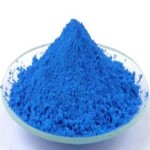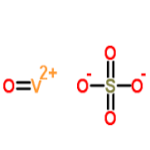Vanadyl Sulfate SDS of Suppliers Exporters, Manufacturers
Vanadyl Sulfate
CAS Number: 27774-13-6 or 123334-20-3 Suppliers Exporters, Manufacturers

Please visit Main Page of Vanadyl Sulfate Manufacturers.
Vanadyl Sulfate or Vanadyl Sulphate SDS Safety Data Sheet
MSDS Sheet 16-May-22
1. Product Identification
Product Name & Other Names: Vanadyl Sulfate or Vanadyl Sulphate.
CAS No.: 27774-13-6 or 123334-20-3
EINECS EC Number: 248-652-7
Relevant uses and uses advised against (if any): Industrial Manufacturing.
Suppliers: As per letterhead.
2. Hazards Identification
GHS, Globally Harmonized System Classification in accordance with 29 CFR 1910
Classification according to Regulation (EC) No 1272/2008
Acute toxicity, oral Category 4, H302
Skin corrosion/irritation Category 2, H315
Serious eye damage/eye irritation Category 2A, H319
Specific target organ toxicity, single exposure; Respiratory tract irritation Category 3, H335
Labeling according to Regulation (EC) No 1272/2008
GHS Label Elements  Irritant |
Signal Words: Warning
Hazard statements:
H302: Harmful if swallowed.
H315: Causes skin irritation.
H319: Causes serious eye irritation.
H335: May cause respiratory irritation.
Precautionary statements:
P262: Do not get in eyes, on skin, or on clothing.
P264: Wash skin thoroughly after handling.
P280: Wear protective gloves/protective clothing/eye protection/face protection.
P270: Do not eat, drink or smoke when using this product.
P273: Avoid release to the environment.
P330: Rinse mouth.
P362: Take off contaminated clothing and wash before reuse.
P301+312: IF SWALLOWED: Call a POISON CENTER or doctor/physician if you feel unwell.
P332+313: If skin irritation occurs: Get medical advice/attention.
P302+P352: IF ON SKIN: Wash with plenty of soap and water.
P305+351+P338: IF IN EYES: Rinse cautiously with water for several minutes. Remove contact lenses, if present and easy to do. Continue rinsing.
P332+313: If skin irritation occurs: Get medical advice/attention.
P337+P313: If eye irritation persists: Get medical advice/ attention.
3. Composition/Information on Ingredients
Product Name & Other Names: Vanadyl Sulfate or Vanadyl Sulphate.
CAS No.: 27774-13-6 or 123334-20-3
EINECS EC Number: 248-652-7
Molecular Weight: 163 (anhydrous).
4. First Aid Measures
Always get medical attention after the first aid is over.
Inhalation: Remove to fresh air. Give oxygen if breathing is difficult; give artificial respiration if breathing has stopped. Keep person warm and quiet; get medical attention.
Ingestion: Induce vomiting immediately if directed by medical personnel. Never give anything by mouth to an unconscious person.
Skin Contact: Immediately flush skin with plenty of soap and water for at least 15 minutes. Remove contaminated clothing and shoes. Wash clothing before reuse. Thoroughly clean shoes before reuse. Get medical attention if irritation develops.
Eye Contact: Immediately flush eyes with plenty of water for at least 15 minutes, lifting upper and lower eyelids occasionally. Get medical attention.
5. Fire Fighting Measures
Fire: Not considered to be a fire hazard.
Fire Extinguishing Media: Use water spray, alcohol-resistant foam, dry chemical or carbon dioxide.
Special hazards arising from the substance or mixture: Sulphur oxides, Vanadium Compounds.
Extinguishing Media Not recommended: None specified.
Special Information: In the event of a fire, wear full protective clothing and NIOSH-approved self-contained breathing apparatus with full face piece operated in the pressure demand or other positive pressure mode. At high temperatures under fire conditions, it may produce toxic or irritating fumes. Fire-extinguishing work is done from the windward and the suitable fire-extinguishing method according to the surrounding situation is used.
6. Accidental Release Measures
Personal precautions, protective equipment, and emergency procedures: Avoid dust formation. Avoid breathing dust/fumes/gas/mist/vapors/spray. Ensure adequate ventilation. Use individual protective equipment (waterproof boots, suitable protective clothing, safety glasses, etc.). Do not approach facing the wind.
Environmental precautions: Do not let the product enter drains, soil, or water sources.
Methods and materials used for containment cleanup procedures and Storage: Contain spilled material. Cover with an inert, non-combustible absorbent material, (e.g., sand, earth, diatomaceous earth, vermiculite). Vacuum or sweep-up and remove to an approved disposal container.
7. Handling and Storage
Precautions for safe handling: Apply according to good manufacturing and industrial hygiene practices. Ensure proper ventilation. Wash thoroughly after handling. Do not drink, eat, or smoke while handling. Avoid contact with skin, eyes, and clothing. Minimize dust generation. Avoid breathing dust/fumes/gas/mist/vapors/spray. Use individual protective equipment (waterproof boots, suitable protective clothing, safety glasses, etc.).
Conditions for safe storage, including any incompatibilities: Store in cool, dry, and ventilated area away from heat sources and protected from sunlight in tightly closed original container. Keep air contact to a minimum. Do not leave the material container open. Store protected from heat, sparks and ignition sources and incompatible materials. Do not store with incompatible materials like strong oxidizing agents. Containers may be hazardous when empty.
8. Exposure Controls/Personal Protection
Airborne Exposure Limits: Ceiling: 0.05 mg/m3 as per NIOSH IDLH
Ventilation System: In general, dilution ventilation is a satisfactory health hazard control for this substance. However, if conditions of use create discomfort to the worker, a local exhaust system should be considered.
Personal Respirators (NIOSH Approved): Not expected to require personal respirator usage. For conditions of use where exposure to dust or mist is apparent and engineering controls are not feasible, a particulate respirator (NIOSH type N95 or better filters) may be worn.
Skin Protection: Wear protective gloves and clean body-covering clothing.
Eye Protection: Use chemical safety goggles and/or full-face shield where dusting or splashing of solutions is possible. Maintain eye wash fountain and quick-drench facilities in work area.
Other Control Measures: Maintain good housekeeping in work area. Handle in accordance with good industrial hygiene and safety practice.
9. Physical and Chemical Properties
Appearance: Blue crystals or crystalline powder.
Odor: Odorless.
Odor threshold: Not applicable.
pH: No data found.
Relative density: No data found.
Boiling Point: Decomposes.
Melting Point: 105C literature.
Flash point: No data found.
Auto-ignition temperature: No data found.
Decomposition temperature: No data found.
Upper/lower flammability or explosive limits: No data found.
Vapor pressure: No data found.
Vapor density: No data found.
Evaporation rate: No data found.
Flammability (solid, gas): No data found.
Partition coefficient: n-octanol/water: No data found.
Solubility: Soluble in water.
Viscosity: No data found.
Molecular Weight: 163 (anhydrous)
Chemical Formula: VOSO4-xH2O
10. Stability and Reactivity
Stability: Stable under ordinary conditions of use and storage.
Hazardous Decomposition Products: May produce oxides of Sulfur and Vanadium on decomposition.
Hazardous Polymerization: Will not occur.
Incompatibilities: Strong oxidizing agents, Moisture.
Conditions to Avoid: Heat, flame, dusting, and incompatibles.
11. Toxicological Information
LD50 Dermal 4450 mg/kg ( Rabbit ).
LD50 Oral 4450 mg/kg ( Rat 467).
Carcinogenic Effects: Not a reported carcinogen by IARC, NTP, ACGIH, OSHA or California proposition 65.
Mutagenic Effects: No data found.
Developmental Toxicity: No data found.
Reproductive Effects: No data found.
12. Ecological Information
Toxicity: No data found.
Environmental Fate: When released into the soil, this material is not expected to evaporate significantly. When released into water, this material is not expected to evaporate significantly.
Persistence and Degradability: No data found.
Mobility: Likely to be mobile due to water solubility.
Bioaccumulation/ Accumulation: Not likely to accumulate due to water solubility.
Results of PBT and vPvB assessment: No data found.
13. Disposal Considerations
Whatever cannot be saved for recovery or recycling should be managed in an appropriate and approved waste disposal facility.
14. Transport Information
DOT USA, TDG Canada & ADR/RID Europe :
UN number: 2931 Class: 6.1 Packing group: II
Proper shipping name: Vanadyl sulfate.
IMDG/IMO:
UN number: 2931 Class: 6.1 Packing group: II
Proper shipping name: Vanadyl sulfate.
ICAO/IATA:
UN number: 2931 Class: 6.1 Packing group: II
Proper shipping name: Vanadyl sulfate.
15. Regulatory Information
USA:
SARA 311/312 Hazardous Categorization: See section 2.
California Proposition 65: This product does not contain any Proposition 65 chemicals.
16. Other Information
DISCLAIMER: The information and recommendations set forth herein are presented in good faith and believed correct as of the date hereof. It is compiled from various sources, and it is not necessarily all inclusive nor fully adequate in every circumstance. In addition, these suggestions should not be confused with nor followed in violation of applicable laws, regulations, rules, or insurance requirements applicable. This SDS MSDS sheet is intended only as a guide to the appropriate precautionary handling of the material by a professionally trained person using this product. Individuals receiving the information must exercise their independent judgment in determining its appropriateness for a particular purpose. This shall not constitute a guarantee for any specific product features and shall not establish a legally valid contractual relationship. In no case shall our company be liable to loss or damages by the product user.

Please visit Technical Data Sheet of Vanadyl Sulfate Suppliers.
Vanadyl Sulfate CAS Number 27774-13-6 or 123334-20-3 & Vanadium BMOV or Bis(maltolato)oxovanadium Vanadium CAS Number 38213-69-3 Supplier Exporter, Manufacturer:
Annie Chemie P Ltd
Mumbai 4000010, INDIA
With Agents and offices in UAE, USA, Europe.
e-mail: info@anniechemie.com
Copyright and Usual Disclaimer is Applicable.
June 3, 2025
Exporters to USA, Canada, UK, Europe, UAE, Nigeria, Algeria, Turkey, Mexico, Brazil, Chile, Argentina, Australia, Dubai etc.
Perfection is made up of small things and that is a big thing.
